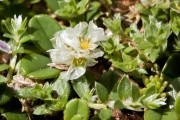Paronychia capitata capitata
(Paronychia capitata capitata)

Description
Paronychia argentea is an herbaceous plant from the family Caryophyllaceae that grows in sandy areas, ways, abandoned fields and dry terrains. It is an annual species with procumbent habits, which reaches 30 cm height. Similar to Paronychia capitata but with almost all glabrous leaves, a rigid and prominent sow, and calyx lobules with transparent margins. The stem is glabrous or pubescent, with opposite, elliptical and mucronate leaves. The flowers grow in lateral and terminal glomerulus. They are hermaphrodite, pentamerous and actinomorphic, accompanied with scaly silver bracts bigger that themselves. The fruit is an achene. They can be encountered all around the Mediterranean Sea. It grows in abandoned or dry terrains, dunes and ditches, and flourishes from winter to summer. It is used stewed, as a diuretic and blood purifier, and as a plaster to cure wounds. Paronychia is a genus of plants in the family Caryophyllaceae with over 110 species worldwide, mostly from warm-temperate North America, Eurasia, South America and Africa. They are herbs that are annual or biennial or perennial in life span. Some species have a woody base. For the most part they have small, white to yellow-white colored flowers that are often hidden within the paired bracts. The genus Siphonychia has been incorporated into Paronychia by botanists. The common names for some of the species include chickweed, nailwort, and Whitlow-wort. The genus gets its name from the disease of the fingernails which it was once thought to cure. Traditional healers in modern-day use species of this genus to treat kidney stones.
Taxonomic tree:







